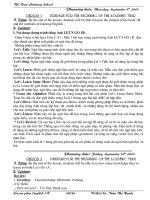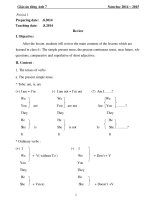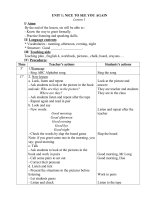GIÁO án TIẾNG ANH lớp 4 mới tập HUẤN CT của bộ
Bạn đang xem bản rút gọn của tài liệu. Xem và tải ngay bản đầy đủ của tài liệu tại đây (155.91 KB, 16 trang )
English 4
Week 1 – Period 1+2
Date of preparation: Tuesday, August 19th 2015
Date of teaching : Tuesday, August 26th 2015
REVIEW
I. Overview
1. Aims and Objectives
Aims:
To help Ss to summary about: greetings, name, age, school and classroom,
objects, games and activities at break time, family, house, places in school, toys and
animals, weather, ...
Objectives:
By the end of the lesson, Ss will be able to: greet and talk about: name, age,
school and classroom, school objects, games and activities at break time, family,
house, places in school, toys and animals, weather; sing the songs in grade 3.
2. Language focus
Phonics:
‘b’, ‘h’, ‘m’, ‘p’, ‘t’, ‘y’, ‘f’, ‘s’, ‘a’, ‘e’, ‘c’, ‘d’, ‘g’, ‘l’, ‘r’, ‘th’,
‘i’, ‘o’, ‘bl’, ‘sk’, ‘h’, ‘m’, ‘p’, ‘t’, ‘y’, ‘f’, ‘s’, ‘a’, ‘e’, ‘c’, ‘d’, ‘g’, ‘l’, ‘r’,
‘th’,
Vocabulary:
Words to talk about names, ages, school things, house’s rooms, toys, family,
weather, greetings, …
Sentence Patterns:
Hi/Hello. I’m……/ My name’s…..
What’s (your) name? (My) name’s….
How are you? I’m fine. Thanks/ Thank you.
How old are you? –I’m .. years old.
What’s its name? Its name’s…..
Is it school (big)? Yes, it is. / No, it isn’t.
Who’s that? That’s…
There are (two) (bedrooms) in my house.
There is one (kitchen) in my house.
How many (dogs) do you have? I have …..
He/ She has …..
What color is it? – It’s green.
Where are the (balls)? They’re over there.
3. Teaching/ Learning aids:
Student’s book, recording, puppets,
II. PROCEDURES
- T gets Ss review the vocabularies in chorus, in pairs, in groups.
- T gets Ss review the structures in groups and in pairs. T helps Ss when
necessary
1
Week 1 – Period 3
Date of preparation: 2015
Date of teaching : 2015
Unit 1: Nice to see you again.
Lesson 1:
I. OVERVIEW
Objectives:
Language focus:
Resources:
II. PROCEDURE
Steps
1. Warm-up
2. Look, listen &
repeat
1. Look, listen and tick.
2. Point and say.
Let’s talk.
By the end of period, Ss will be able to: greet and respond to greetings
formally, using Good morning / Good afternoon/ Good evening and Nice
to see you again.
+ New word: morning, afternoon, evening, night, tomorrow, later, again,
see, meet.
+ Structures: Good morning / Good afternoon/ Good evening and Nice
to see you again.
Ss’ book, recording, fresh cards, puppets, posters, ….
Learning activities
-Get Ps sing a song How
are you again.
-Play the recording a few
time for Ps to listen and
sing the song again.
Language focus
Modes
Hello, Peter. How
T-Whole class
are you?
I’m fine, thank you.
How are you?
Thank you, Peter. I’m
fine too.
Let’s go to school
together.
How are you, Nam,
Quan and Mai?
We’re fine, thank
you, Miss Hien.
- Tell pupils that they are
T-Whole class
going to learn to: greet and
respond
to
greetings
formally.
- Have them look at the
four pictures to discuss the
contexts in which the
language is use. Ask them
questions such as Who are
they?/ Where are they?/ -Good
morning,
What are they talking class.
about?
-Good morning, Miss
Picture a: The pupils meet Hien.
Miss Hien formally in the 2
3. Point & say
classroom using Good
morning, Miss Hien..
Good morning, class.
Picture b: Miss Hien
responds to her Ps’
greeting using -Nice to
meet you again.
Picture c: Miss Hien and a
P greet each other. How
are you, Mai?-I’m very
well, thank you. And you?
Picture d: Nam greets Miss
Hien when he comes into
the classroom late, saying
Good morning, Miss Hien.
I’m late!-Yes, come in.
- Play the recording a few
time for Ps to listen and
repeat. Do choral and
individual
repetition,
pointing to the characters
speaking.
- Play the recording again
for Ps to listen and say
along.
-Tell Ps that they are going Good morning/ Good
to practice greeting and afternoon and Good
responding to each other evening.
formally by Good morning
/ Good afternoon and
Good evening.
- Have them look pictures
to understand how the
language is used in
different contexts. Point to
the first picture and elicit
the formal greeting used in
the morning. Ask Ps to say
the phrase chorally and
responding to greeting in
pairs, using the prompts in
bubbles.
Picture a: Good morning,
Miss Hien.
Good morning, Mai.
Picture b: Good
afternoon, Mr Loc.
Good afternoon, Phong.
Picture c: Good evening,
Mr Thanh.
Good evening, Miss …
Work in
pairs/groups
Whole class
T-Whole class
Pairs or groups
Pairs- WC
3
4. Let’s talk
5. Homelink
Repeat
the
same
procedure with the rest of
pictures.
- Call a few pairs to act out
in front of the class. Check
as a class and correct
pronunciation,
if
necessary.
- Tell pupils that they are
going to revise what they
have learnt it in Activity 1
and 2 in real contexts.
- Remind pupils how to
use Good morning / Good
afternoon/ Good evening
to greet each other
formally and how to use
See you tomorrow/ See
you later/ Good night to
respond to
Goodbye/
Good night.
- First get one pupil to act
as a teacher and he/she
greets the other formally,
using Good morning /
Good afternoon/ Good
evening. Nice to meet you.
Then ask pupils to say
goodbye to each other,
using Goodbye. See you
tomorrow and then say
Good night. Put the
sentences on the board and
do choral and individual
repetition, if necessary.
Have pupils work in pairs,
acting out how to greet and
say goodbye.
- Call a few pairs to act out
in front of the class.
Correct the pronunciation,
if necessary.
- Have pupils practice
greeting and responding
the other formally use
Good morning / Good
afternoon/ Good evening
and how to use See you
tomorrow/ See you later/
Good night to respond to
See you tomorrow/
See you later/ Good
night
Goodbye/ Good night
T-Whole class
Work in pairs
/groups
Work in pairs
Good morning /
Good afternoon/
Good evening.
See you tomorrow/
See you later/ Good
night/Goodbye.
Individual
4
Goodbye/ Good night at
home.
Week 1 – Period 4
Date of preparation: 2015
Date of teaching : 2015
Unit 1: Nice to see you again.
Lesson 1:
I. OVERVIEW
Objectives:
Language focus:
Resources:
3. Listen and tick.
4. Look and write.
5. Let’s sing.
By the end of period, Ss will be able to: listen to dialogues about greeting
and responding and tick, using Good morning / Good afternoon/ Good
evening and Nice to see you again; look and write the missing word
under the each picture.
+ New word: Revision the words: morning, afternoon, evening, night,
tomorrow, later, again, see, meet.
+ Structures: Revision the sentence: Good morning / Good afternoon/
Good evening and Nice to see you again.
Ss’ book, recording, fresh cards, puppets, posters of the song Good
morning to you.
II. PROCEDURE
Steps
1. Warm-up
2. Listen and tick
Learning activities
Spend a few minutes
revising
-Tell Ps that they are going
to listen to three dialogues
about
how
people
greet/say goodbye and tick
the correct pictures.
-Have Ps look at the
pictures to identify the
similarities and different
between pictures. (The Ps
and T are greeting each
other at different times of
the
day).
Check
understanding.
-Playing the recording a
few times. Ask pupils to
Language focus
Good morning /
Good
afternoon/
Good evening and
Nice to see you
again.
Modes
T-Whole class
Whole class
Whole class
5
3. Look and write
4. Let’s sing
listen to the recording and
tick the correct pictures.
Tell Ps not to worry if they
cannot understand every
word, and that they should
focus on who Miss Hien is
talking to (Dialogue 1),
when they are speaking
(Dialogue 2), and to whom
Mai
says
goodbye
(Dialogue 3).
-Get Ps to swap their
answer
their
answers
before you check as a
class. Monitor activity and
offer help when necessary.
-Tell Ps that they are going
to fill the gaps with
morning, afternoon or bye.
-Give them a few seconds
to look at the pictures.
First, focus Ps on the time
of the day the greetings are
used and the people who
use the greetings (Picture 1
and 2). Remind them that
the two children are
leaving school in Picture 3.
Then
have
Ps
fid
appropriate
words
to
complete the phrases. If
necessary, get Ps to work
in pairs.
-Give Ps time to do the
task independently. Go
around and offer help, if
necessary.
-Get them to swap their
answers before checking
as a class. If there is
enough time, call some Ps
to read aloud the complete
sentences.
-Tell them that they are
going to sing a song.
- Hang poster of the song
Good morning to you on
the board. Have them read
each line of the lyrics.
Explain the new words or
Whole class
1. Good morning
2. Good afternoon
3. Goodbye
T-Whole class
Pairs or groups
Whole class
Good morning to you
T-Whole class
Good morning to you.
Good morning to you.
Good morning, dear
Miss Hien.
Good morning to you.
6
structures, if necessary.
Check comprehension.
-Play the recording all the
way through. Ask Ps to do
choral and individual
repetition of the song.
When pupils are familiar
with the tune, ask a group
to the front of the class to
sing the song. The class
may sing along and clap
hands or do actions.
-Have the class sing the
song again and clap their
hands or do actions
reinforce the activity.
- Pupils sing and write the
song Good morning to you
on Page 7 at home again.
5. Homelink
Good morning to you.
Good morning to you.
Good morning, dear
children.
Good morning to you.
Whole class
Work in groups
Whole class
Individual
_________________________________
Week 2 – Period 5
Date of teaching
:
2015
Unit 1: Nice to see you again.
Lesson 2:
I. OVERVIEW
Objectives:
Language focus:
Resources:
II. PROCEDURE
Steps
1. Warm-up
1. Look, listen and tick.
2. Point and say.
3. Let’s talk.
By the end of period, Ss will be able to: say and respond to goodbye,
using Goodbye/Bye/ Good night and See you to morrow/ See you later.
+ New word: bye, night, tomorrow, later, see.
+ Structures: Goodbye/Bye/ Good night and See you to morrow/ See you
later.
Ss’ book, recording, fresh cards, puppets, posters, ….
Learning activities
-Call some Ps to front of
the class to sing the song
Language focus
Modes
T-Whole class
Good morning to you. The
class may sing the song, clap
the hands.
2. Look, listen &
repeat
- Tell pupils that they are Goodbye/Bye /See
going to learn to: say and you to morrow.
T-Whole class
7
3. Point & say
respond to goodbye.
- Have them look at the
four pictures to understand
the contexts in which the
language is used. Ask
them questions such as
Who are they?/ Where are
they?/ What are they
saying?. Focus Ps on the
first picture. Elicit how
Hoa greets Miss Hien and
introduces herself, using
Good morning, Miss Hien.
I’m Hoa. I’m a new pupil.
Picture b: Miss Hien and
Hoa greet each other,
Miss Hien responds to her
Ps’ greeting using Nice to
meet you, too.
Picture c: Hoa says
goodbye Miss Hien and
Miss Hien responds to
Hoa, saying See you to
morrow.
Check
understanding.
- Play the recording a few
time for Ps to listen and
repeat. Do choral and
individual
repetition,
pointing to the characters
speaking.
- Play the recording again
for Ps to listen and say
along.
-Tell Ps that they are going
to practice saying and
responding to goodbye.
- Draw their attention to
the pictures to understand
how the language is used
in different contexts. Ask
Ps to look at the first two
pictures. Tell them that
they are going to practice
saying and responding to
Goodbye.
See
you
tomorrow./later. In the
third picture, the girl uses
Good night to respond to
her parents before going to
bed.
Pairs or groups
Whole class
Whole class
Goodbye/Bye/ Good
night /See you to
morrow/ See you
later.
T-Whole class
8
4. Let’s talk
-Point to the first picture
and get one P to say
Goodbye.
See
you
tomorrow, and another to
respond Goodbye. See you
tomorrow. Repeat the
procedure with the next
pictures. Point to the third
picture and get one P to
say Good night, and
another respond Good
night.
-Ask Ps to work in pairs,
pointing to the characters
speaking.
- Call on a few pairs to act
out in front of the class.
Check as a class and
correct pronunciation, if
necessary.
-Tell Ps that they are going
to revise what they have
learnt in Lesson 1 and 2.
Remind Ps how to use
Good
morning/Good
afternoon/good evening to
greet each other formally
and how to use See you
tomorrow/ See you later/
Good night to respond to
Goodbye/ Good night.
-First, get one P to act as a
teacher. He/She greets the
others formally, using
Good
morning/Good
afternoon/Good evening.
Nice to meet you. Then ask
Ps to say goodbye to each
other, using Goodbye. See
you tomorrow, and then
say Good night. Put the
sentences on the board and
do choral and individual
repetition, if necessary.
-Have Ps work in pairs,
acting out how to greet and
say goodbye.
-Call on a few pairs to act
out the dialogue if front of
the class. Correct the
pronunciation,
if
Individual- WC
Work in pairs
Pairs-WC
Good morning/Good T-Whole class
afternoon/good
evening/See
you
tomorrow/ See you
later/
Good
night
/Goodbye/
Good night.
Pairs or groups
Pairs -WC
9
necessary.
-Pupils practice saying
and
responding
to
goodbye, used See you
tomorrow/later./Good
night at home.
5. Homelink
Individual
_____________________________________________________
Week 2 – Period 6
Date of teaching
:
2015
Unit 1: Nice to see you again.
Lesson 2:
I. OVERVIEW
Objectives:
Language focus:
Resources:
II. PROCEDURE
Steps
1. Warm-up
2. Listen and
number
4. Listen and number.
5. Look and write.
6. Let’s play.
By the end of period, Ss will be able to: listen to dialogues about greeting
and responding and number, using Goodbye/Bye/ Good night and See you
to morrow/ See you later; look and write the missing word under the each
picture.
+ New word: Revision the words: bye, night, tomorrow, later, see.
+ Structures: Revision the sentences: Goodbye/Bye/ Good night and See
you to morrow/ See you later.
Ss’ book, recording, fresh cards, puppets, posters of the game.
Learning activities
-Get Ps to revision lesson
by asking some pairs to
greet each other. Good
morning / Good
afternoon/ Good evening
and Nice to see you again.
Goodbye/Bye/ Good night
and See you to morrow/
See you later.
-Tell Ps that they are
going to listen to three
dialogues about how
people greet/say goodbye
and tick the correct
pictures.
-Have Ps look at the
pictures to identify the
similarities and different
between pictures. (The Ps
Language focus
1.
Tom: Good morning,
Miss Hien.
M.H: Good morning.
What’s your name?
T: My name’s Tom.
T-O-M, Tom White.
I’m from America.
2.
P: Hi, Tom. How are
Modes
Work in pairs
T-Whole class
Whole class
10
3. Look and write
4. Let’s play
and T are greeting each
other at different times of
the
day.)
Check
understanding.
-Play the recording a few
times. Ask Ps to listen the
recording and tick the
correct pictures. Tell them
not to worry if they cannot
understand every word,
and that they should focus
on who Miss Hien is
talking to (Dialogue 1),
when they are speaking
(Dialogue 2), and to
whom Mai says goodbye
(Dialogue 3).
-Get Ps to swap their
answer before you check
as a class. Monitor the
activity and offer help
when necessary.
-Tell Ps that they are
going
to
read
the
dialogues and fill in gaps,
using the pictures cues.
-Ask them to look the
dialogue 1. Explain that
they need to fill the gaps
with place A is from the
name of B. Then ask them
to look at the pictures to
identify the answers. Have
Ps look at Dialogue 2.
Tell them that they are
going to fill in the missing
words when Tom greets
Mr Loc in the morning. In
Dialogue 3, Ps fill the
words that Tom says to
his mum before going to
bed. Check understanding.
-Set a time limit for Ps to
do the task independently.
Go around and offer help,
if necessary.
-Get Ps to swap their
answers before checking
as a class.
-Tell Ps that they are
you?
T: Hi, Phong. I’m
very well, thank you.
And you?
P: I’m fine, thanks.
3.
-Hello. I’m Tom. I’m
from America.
-Hello, Tom. I’m Mai.
I’m from Viet Nam.
-Nice to meet you,
Mai.
-Nice to meet you, too.
4.
-Goodbye, Mr Loc.
Bye-bye, Tom. See
you tomorrow.
1.
A: Hello, I’m Mai.
I’m from Viet Nam.
B: Hello, I’m Tom.
I’m from America.
2.
A: Good morning, Mr
Loc.
B: Good morning,
Tom. Nice to meet
you.
3.
A: Good night, mum.
B: Good night, Tom.
Whole class
Whole class
T-Whole class
Work in
pairs/groups
Whole class
T-Whole class
11
going to play the game
Bingo.
-Draw a word grid on the
board and ask Ps to copy
it. Have them tell you the
words they have learnt in
their lessons. List the
words on the board. Each
P chooses nine words
from the list to copy into
their grid. While they are
doing this, copy each
word onto a piece of
paper, put the pieces of
paper into the bag and mix
them up. Select Ps to pick
out a piece of paper and
call out the word. Ps with
that word in their grid can
cross it out. The quickest
P to cross out an entire
row of the words in their
grid and call out Bingo is
the winner. You can
continue the game until a
P has crossed out all the
words.
-Have Ps do a dictation,
using the phrases learnt in
the previous lessons at
home.
Goodbye, Bye, Good
night, See you to morrow,
See you later.
5. Homelink
Week 2 – Period 7
Good
mornin
g
Hello
Nice to
meet
you.
Good
afternoo
n
Good
night
Good
evening
Hi
Whole class
Bye
Goodby
e
Groups
Whole class
Individual
Date of preparation: 2015
Date of teaching : 2015
Unit 1: Nice to see you again.
Lesson 3:
I. OVERVIEW
Objectives:
Language focus:
1. Listen and repeat.
2. Listen and circle. Then …
3. Let’s chant.
By the end of period, Ss will be able to: pronounce the sounds of the
letters l and n in the words Linda and night respectively.
+ New word: Revision the words: bye, night, tomorrow, later, see.
12
Resources:
+ Structures: Revision the sentences: Goodbye/Bye/ Good night and See
you to morrow/ See you later.
Ss’ book, recording, fresh cards, puppets, posters of the chant Hello,
friends!
II. PROCEDURE
Steps
1. Warm-up
2. Listen & repeat
3. Listen and circle.
Then write and say
aloud.
Learning activities
-Get Ps to do a dictation,
using the phrases learnt in
the previous lessons.
Goodbye, Bye, Good
night, See you to morrow,
See you later.
-Tell Ps that they are going
to practice saying the
sounds of the letters l and
n in the words Linda and
night respectively.
-First, put the letter l and n
on the board. Play the
recording and ask Ps to
repeat a few times and let
Ps say the words and the
phrases, paying attention
to the target sounds.
-Do choral and individual
repetition of the sounds,
words and phrases until Ps
feel confident.
-Get some Ps to perform in
front the class. Check as a
class and correct the
pronunciation,
if
necessary.
-Tell Ps that they are going
to listen to recording,
circle the correct options
and then write the words in
the blanks.
-Give them a few seconds
to read the sentences in
silence and guess the
words to fill the gaps.
-Have Ps listen to the
recording and circle the
appropriate options. Allow
them time to do the task
independently.
If
necessary, have Ps listen to
the recording more than
once.
Language focus
Modes
Whole class
l Linda Hello, Linda T-Whole class
n night Good night
Individual
1. Hello, I’m …
T-Whole class
a. Linda b. Nam
2. I’m from …
a. Viet Nam
b. England
3. ……. My name’s
Linda.
a. Hi b. Hello
4. Good …..
a. night
b. afternoon
13
4. Let’s chant
5. Homelink
Week 2 – Period 8
-Give them time to write
the words in the gaps
independently. Have them
swap their answers before
checking as a class. Go
around and offer help, if
necessary.
-Ask Ps to read the
sentences aloud.
-Tell them that they are
going to read a chant.
-Have them read each line
of the lyrics. Explain the
new words or structures, if
necessary.
Check
comprehension.
-Play the recording all the
way through. Ask Ps to do
choral and individual
repetition of the chant.
When pupils are familiar
with the tune, ask a group
to the front of the class to
read the chant. The class
may read along and clap
hands or do actions.
-Have the class read the
chant again and clap their
hands or do actions
reinforce the activity.
-Have Ps read and do a
dictation, using the chant
learnt in the previous
lessons at home.
- Do tasks in Workbook
Unit 1.(A, B)
Groups or pairs
Whole class
Hello. I’m Linda.
I’m from England.
Nice to meet you, Linda.
T-Whole class
Hello. I’m Nam.
I’m from Viet Nam.
Nice to meet you, Linda.
Hello. Linda.
Hello, Nam.
We’re friends.
Whole class
Groups
Pairs
Whole class
Individual
Date of preparation: 2015
Date of teaching : 2015
Unit 1: Nice to see you again.
Lesson 3:
4. Read and answer.
5. Write about you.
6. Project.
14
I. OVERVIEW
Objectives:
Language focus:
Resources:
II. PROCEDURE
Steps
1. Warm-up
By the end of period, Ss will be able to: read and write a short paragraph
about themselves.
+ New word: Revision of words: bye, night, tomorrow, later, see.
+ Structures: Revision of sentences: Goodbye/Bye/ Good night and See
you to morrow/ See you later.
Ss’ book, recording, fresh cards, puppets, posters, ….
2. Read and answer
3. Write about you
Learning activities
-Get Ps read and copy the
chant on the board, using
the chant Hello, friends!
learnt in the previous
lessons.
-Tell Ps that they are going
to read the two texts and
answer the four questions.
-Get them to read the first
text and focus on the
information to answer the
first two questions (what
the girl’s name is and
where she is from). Then
ask them to read the
second texts to answer the
last two questions (what
the boy’s name and where
he is from). If necessary,
get Ps to work in pairs or
small groups.
-Give Ps time to do the
task independently. Go
around and offer help, if
necessary.
-Get them to swap their
answers before checking
as a class. If there is
enough time, let some
pairs ask and answer the
questions.
-Tell Ps that they are going
to write a short paragraph
about themselves.
-Have them work in pairs
or group to discuss what
are they going to write.
Focus Ps on their names,
Language focus
Modes
Work in group
T-Whole class
Keys:
1. Her name’s Do Thuy
Hoa.
2. She’s from Ha Noi,
Viet Nam.
3. His name’s Tony
Jones
4. He’s from Sydney,
Australia.
Work in pairs
Individual
Individual-WC
T-Whole class
My name is …
I am from …
My school is …
15
4. Project
5. Homelink
Week – Period
their hometowns and the
name of their school.
Check comprehension.
-Give Ps time to do the
task independently. Go
around and offer help, if
necessary.
-Get them to swap their
answer before checking as
a class.
-If there is time, ask one P
to write the answer on the
board.
-Tell Ps that they are going
to do a project. Explain the
activities
and
check
understanding.
-Give each P a small card.
Let Ps to copy the four
categories from book onto
their cards.
-Ask them to write the
information
about
themselves.
Encourage
them to decorate their
cards. Get them to swap
their cards in pairs. They
should look at their
partners’
cards
and
describe each other.
-Call some Ps to the front
of the class and tell the
class about their partners’
cards. To make this
activity more challenging,
you may ask them not to
look at the cards.
-Have Ps revision greeting
and responding learnt in
the previous Unit1 at
home.
- Do tasks in Workbook
Unit 1.
Work in
pairs/groups
T-Whole class
Name: …….
Hometown: …..
School: ……
Class: ……..
Work in
pairs/groups
Work in pairs
Individual
Date of preparation: 2015
Date of teaching : 2015
16









